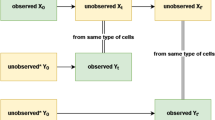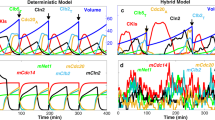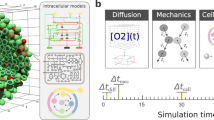Abstract
Systems biology iteratively combines experimentation with mathematical modeling. However, limited mechanistic knowledge, conflicting hypotheses and scarce experimental data severely hamper the development of predictive mechanistic models in many areas of biology. Even under such high uncertainty, we show here that ensemble modeling, when combined with targeted experimental analysis, can unravel key operating principles in complex cellular pathways. For proof of concept, we develop a library of mechanistically alternative dynamic models for the highly conserved target-of-rapamycin (TOR) pathway of Saccharomyces cerevisiae. In contrast to the prevailing view of a de novo assembly of type 2A phosphatases (PP2As), our integrated computational and experimental analysis proposes a specificity factor, based on Tap42p-Tip41p, for PP2As as the key signaling mechanism that is quantitatively consistent with all available experimental data. Beyond revising our picture of TOR signaling, we expect ensemble modeling to help elucidate other insufficiently characterized cellular circuits.
This is a preview of subscription content, access via your institution
Access options
Subscribe to this journal
Receive 12 print issues and online access
$209.00 per year
only $17.42 per issue
Buy this article
- Purchase on Springer Link
- Instant access to full article PDF
Prices may be subject to local taxes which are calculated during checkout




Similar content being viewed by others
References
Kholodenko, B.N. Cell-signalling dynamics in time and space. Nat. Rev. Mol. Cell Biol. 7, 165–176 (2006).
Butcher, E.C., Berg, E.L. & Kunkel, E.J. Systems biology in drug discovery. Nat. Biotechnol. 22, 1253–1259 (2004).
Klipp, E., Nordlander, B., Kruger, R., Gennemark, P. & Hohmann, S. Integrative model of the response of yeast to osmotic shock. Nat. Biotechnol. 23, 975–982 (2005).
Kitano, H. Computational systems biology. Nature 420, 206–210 (2002).
Brown, K.S. et al. The statistical mechanics of complex signaling networks: nerve growth factor signaling. Phys. Biol. 1, 184–195 (2004).
von Dassow, G., Meir, E., Munro, E.M. & Odell, G.M. The segment polarity network is a robust developmental module. Nature 406, 188–192 (2000).
Murphy, J.M. et al. Quantification of modelling uncertainties in a large ensemble of climate change simulations. Nature 430, 768–772 (2004).
Hubner, I.A., Deeds, E.J. & Shakhnovich, E.I. High-resolution protein folding with a transferable potential. Proc. Natl. Acad. Sci. USA 102, 18914–18919 (2005).
Dietterich, T.G. Ensemble methods in machine learning. Lect. Notes Comput. Sci. 1857, 1–15 (2000).
Sachs, K., Perez, O., Pe'er, D., Lauffenburger, D.A. & Nolan, G.P. Causal protein-signaling networks derived from multiparameter single-cell data. Science 308, 523–529 (2005).
Yu, J., Smith, A., Wang, P.P., Hartemink, A.J. & Jarvis, E.D. Advances to Bayesian network inference for generating causal networks from observational biological data. Bioinformatics 20, 3594–3603 (2004).
Turkheimer, F.E., Hinz, R. & Cunningham, V.J. On the undecidability among kinetic models: from model selection to model averaging. J. Cereb. Blood Flow Metab. 23, 490–498 (2003).
Wahl, S.A., Haunschild, M.D., Oldiges, M. & Wiechert, W. Unravelling the regulatory structure of biochemical networks using stimulus response experiments and large-scale model selection. IEE Proc. Syst. Biol. (Stevenage) 153, 275–285 (2006).
Wullschleger, S., Loewith, R. & Hall, M.N. TOR signaling in growth and metabolism. Cell 124, 471–484 (2006).
Cooper, T.G. Transmitting the signal of excess nitrogen in Saccharomyces cerevisiae from the Tor proteins to the GATA factors: connecting the dots. FEMS Microbiol. Rev. 26, 223–238 (2002).
Inoki, K., Ouyang, H., Li, Y. & Guan, K.L. Signaling by target of rapamycin proteins in cell growth control. Microbiol. Mol. Biol. Rev. 69, 79–100 (2005).
Magasanik, B. & Kaiser, C.A. Nitrogen regulation in Saccharomyces cerevisiae. Gene 290, 1–18 (2002).
Zabrocki, P. et al. Protein phosphatase 2A on track for nutrient-induced signalling in yeast. Mol. Microbiol. 43, 835–842 (2002).
Jiang, Y. & Broach, J.R. Tor proteins and protein phosphatase 2A reciprocally regulate Tap42 in controlling cell growth in yeast. EMBO J. 18, 2782–2792 (1999).
Luke, M.M. et al. The SAP, a new family of proteins, associate and function positively with the SIT4 phosphatase. Mol. Cell. Biol. 16, 2744–2755 (1996).
Jacinto, E., Guo, B., Arndt, K.T., Schmelzle, T. & Hall, M.N. TIP41 interacts with TAP42 and negatively regulates the TOR signaling pathway. Mol. Cell 8, 1017–1026 (2001).
Schwefel, H.P. Evolution and optimum seeking. (Wiley, New York; 1995).
Jaqaman, K. & Danuser, G. Linking data to models: data regression. Nat. Rev. Mol. Cell Biol. 7, 813–819 (2006).
Molinaro, A.M., Simon, R. & Pfeiffer, R.M. Prediction error estimation: a comparison of resampling methods. Bioinformatics 21, 3301–3307 (2005).
Beck, T. & Hall, M.N. The TOR signalling pathway controls nuclear localization of nutrient-regulated transcription factors. Nature 402, 689–692 (1999).
Yan, G., Shen, X. & Jiang, Y. Rapamycin activates Tap42-associated phosphatases by abrogating their association with Tor complex 1. EMBO J. 25, 3546–3555 (2006).
Li, H., Tsang, C.K., Watkins, M., Bertram, P.G. & Zheng, X.F. Nutrient regulates Tor1 nuclear localization and association with rDNA promoter. Nature (2006).
Ho, Y. et al. Systematic identification of protein complexes in Saccharomyces cerevisiae by mass spectrometry. Nature 415, 180–183 (2002).
Schmidt, A., Beck, T., Koller, A., Kunz, J. & Hall, M.N. The TOR nutrient signalling pathway phosphorylates NPR1 and inhibits turnover of the tryptophan permease. EMBO J. 17, 6924–6931 (1998).
Di Como, C.J. & Arndt, K.T. Nutrients, via the Tor proteins, stimulate the association of Tap42 with type 2A phosphatases. Genes Dev. 10, 1904–1916 (1996).
Tate, J.J., Rai, R. & Cooper, T.G. Methionine sulfoximine treatment and carbon starvation elicit Snf1-independent phosphorylation of the transcription activator Gln3 in Saccharomyces cerevisiae. J. Biol. Chem. 280, 27195–27204 (2005).
Wang, H., Wang, X. & Jiang, Y. Interaction with Tap42 is required for the essential function of Sit4 and type 2A phosphatases. Mol. Biol. Cell 14, 4342–4351 (2003).
Santhanam, A., Hartley, A., Duvel, K., Broach, J.R. & Garrett, S. PP2A phosphatase activity is required for stress and Tor kinase regulation of yeast stress response factor Msn2p. Eukaryot. Cell 3, 1261–1271 (2004).
Stelling, J., Sauer, U., Szallasi, Z., Doyle, F.J. III, & Doyle, J. Robustness of cellular functions. Cell 118, 675–685 (2004).
Ljung, L. & Ljung, E.J. System Identification: Theory for the User. (Prentice Hall PTR, 1999).
Moles, C.G., Mendes, P. & Banga, J.R. Parameter estimation in biochemical pathways: a comparison of global optimization methods. Genome Res. 13, 2467–2474 (2003).
Harlow, E. & Lane, D. Antibodies: A Laboratory Manual. (Cold Spring Harbor Laboratory Press, Cold Spring Harbor, N.Y.; 1988).
Kitano, H., Funahashi, A., Matsuoka, Y. & Oda, K. Using process diagrams for the graphical representation of biological networks. Nat. Biotechnol. 23, 961–966 (2005).
Acknowledgements
We thank Michael N. Hall, Francis J. Doyle III and Joachim Buhmann for critical reading of the manuscript and helpful suggestions as well as the Swiss National Science Foundation and ETH Zurich for financial support to M.P.
Author information
Authors and Affiliations
Corresponding author
Ethics declarations
Competing interests
The authors declare no competing financial interests.
Supplementary information
Supplementary Text and Figures
Supplementary Notes (DOC 1115 kb)
Supplementary Text and Figures
Supplementary Data 1 (ZIP 12 kb)
Supplementary Text and Figures
Supplementary Data 2 (XLS 202 kb)
Rights and permissions
About this article
Cite this article
Kuepfer, L., Peter, M., Sauer, U. et al. Ensemble modeling for analysis of cell signaling dynamics. Nat Biotechnol 25, 1001–1006 (2007). https://doi.org/10.1038/nbt1330
Published:
Issue Date:
DOI: https://doi.org/10.1038/nbt1330
This article is cited by
-
The mixed blessing of AMPK signaling in Cancer treatments
BMC Cancer (2022)
-
Interactions among mTORC, AMPK and SIRT: a computational model for cell energy balance and metabolism
Cell Communication and Signaling (2021)
-
The applicability of mathematics in computational systems biology and its experimental relations
European Journal for Philosophy of Science (2021)
-
TopoFilter: a MATLAB package for mechanistic model identification in systems biology
BMC Bioinformatics (2020)
-
Coupled feedback regulation of nuclear factor of activated T-cells (NFAT) modulates activation-induced cell death of T cells
Scientific Reports (2019)



